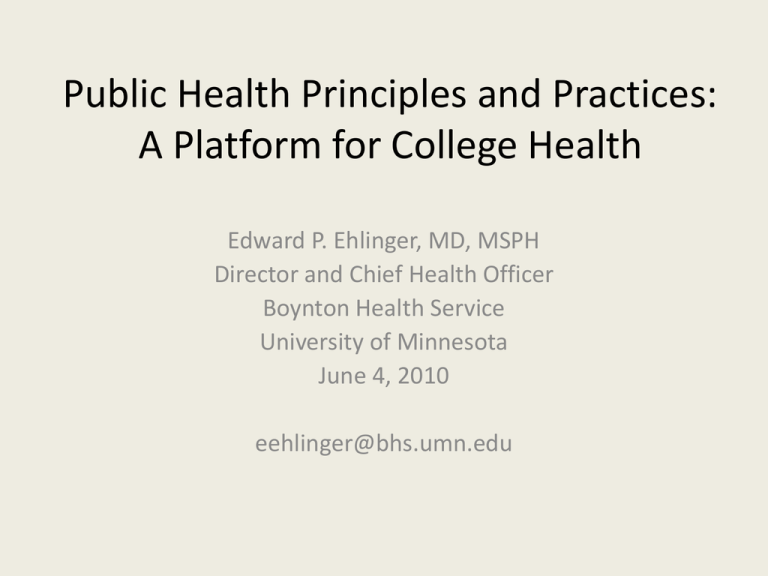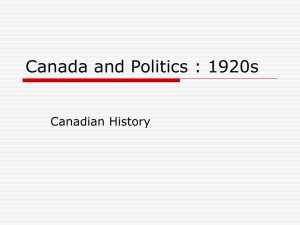
Public Health Principles and Practices:
A Platform for College Health
Edward P. Ehlinger, MD, MSPH
Director and Chief Health Officer
Boynton Health Service
University of Minnesota
June 4, 2010
eehlinger@bhs.umn.edu
Ruth Westheimer
born Karola Ruth Siegel on June 4, 1928
• "Talking from morning to
night about sex has helped my
skiing, because I talk about
movement, about looking
good, about taking risks."
Rosalind Russell
born on June 4, 1911
• “Flops are a part of life's
menu and I've never been
a girl to miss out on any
of the courses.”
Ruth Westheimer
born Karola Ruth Siegel on June 4, 1928
• “Don't stint on
foreplay -- or
afterplay. Be
inventive!”
Dik Browne American cartoonist died on June 4, 1989
He wrote and illustrated Hagar the Horrible and
illustrated Hi and Lois
Examples of strips of his published on June 4th
Dik Browne American cartoonist died on June 4, 1989
Financial pressures
Healthcare reform
The future of College Health is uncertain
• Healthcare reform will raise questions that will
threaten the existence of college health
– “Everyone will have insurance so why have a health
service?”
– “Everyone will have insurance so what is the need
for a health service fee?”
• Some entrepreneurs may see healthcare
reform as an opportunity to gain some college
health business.
• Some in college health may see healthcare
reform as an opportunity to change the model
of college health.
Rosalind Russell
born on June 4, 1911
• "When something
happens to you, you
either let it defeat you,
or you defeat it.“
How will you respond to those
questions and challenges?
How will you convince your
college/university that what you
provide is unique and best meets the
needs of students (and others) on
your campus and the needs of your
institution?
Health is essential to the mission of
Post-Secondary Education
• “When health is absent, wisdom cannot
reveal itself, art cannot become manifest,
strength cannot fight, wealth becomes
useless, and intelligence cannot be
applied.”
• Herophilus of Chalcedon, 335-280 BCE
• Physician to Alexander the Great
No one provides the constellation of
services offered by college health
• On-campus location
• Interest in serving a unique population with
unique needs
• Expertise in serving college students
• Provides a constellation of services not
provided by any other provider
– Services that meet the needs of students and the
campus
– Services that help meet the needs of the broader
community
College Health Services
Service – Teaching - Research
• Medical Care/Primary Care (broadly defined)
• Dental Care
• Occupational Health
• Health Promotion/Wellness
• Health Education
• Student Development
• Environmental Health and Safety
• Public Health
Today is a BIG day in Public Health
June 4, 1912
June 4, 1919
June 4, 1912
• Massachusetts became the first state in the
US to set a minimum wage.
Income
Deaths per 1,000
12.5
10
7.5
5
2.5
0
0
lowest
1
2
Income Groups
3
4
5
highest
June 4, 1919
Thursday, June 5, 1919
Suffrage Wins in Senate; Now Goes to States
Constitutional Amendment Is Passed, 56 to 25, or Two More
Than Two-thirds
Women May Vote In 1920
Leaders Start Fight to Get Ratification by Three-fourths of
States in Time
Debate Precedes Vote
Wadsworth Explains His Attitude In Opposition - Resolution
Signed with Ceremony
19th Amendment
• The right of citizens of the United
States to vote shall not be denied or
abridged by the United States or by
any State on account of sex.
Congress shall have power to enforce
this article by appropriate legislation.
19th amendment to the U. S. Constitution
Dates of Ratification by States
•
•
•
•
•
•
•
•
•
•
•
Illinois, June 10, 1919
Michigan, June 10, 1919
Wisconsin, June 10, 1919
Kansas, June 16, 1919;
New York, June 16, 1919
Ohio, June 16, 1919
Pennsylvania, June 24
Massachusetts, June 25
Texas, June 28, 1919
Iowa, July 2, 1919;
Missouri, July 3, 1919
•
•
•
•
•
•
•
•
•
•
•
Arkansas, July 28, 1919
Montana, August 2, 1919
Nebraska, August 2, 1919
Minnesota, September 8, 1919
New Hampshire, September 10
Utah, October 2, 1919
California, November 1, 1919
Maine, November 5, 1919
North Dakota, December 1, 1919
South Dakota, December 4, 1919
Colorado, December 15, 1919
19th amendment to the U. S. Constitution
Dates of Ratification by States
• Kentucky, January 6, 1920
• Rhode Island, January 6
• Oregon, January 13, 1920
• Arizona, February 12, 1920
• New Mexico, February 21
• Oklahoma, February 28
• West Virginia, March 10
• Indiana, January 16, 1920
• Washington, March 22, 1920
• Wyoming, January 27, 1920
• Tennessee, August 18, 1920.
• Nevada, February 7, 1920
• Became National Law August
26, 1920
• New Jersey, February 9, 1920 • November 2, 1920 – Presidential
election
• Idaho, February 11, 1920
– Warren Harding and Calvin Coolidge elected
1921- The Shepherd-Towner Maternity and
Infant Protection Act
• Authorized grants for state
programs of maternal and
children's services
Sheppard Towner Act
(Maternity and Infancy Care Act)
1921-1929
• First public grants-in-aid program in U.S.
• Developed MCH units in state Health Depts
• Birth registration (30 - 46 states)
• Increased Public Health Nursing
• Partnership of federal and state government
• Not continued because of fear of socialism
• Basis for Title V of Social Security Act
Core Functions of Public Health
• Assessment
• Policy Development
• Assurance
– Institute of Medicine, Future of Public Health
John Sundwall, MD, Ph.D.
• Director of University of Minnesota Health Service
1918-1921
University of Michigan Division of Hygiene and Public
Health 1921-1941
• “Unfortunately, parents, students, and
faculty regard a health service as little
more than a clinic or hospital
concerned only with illness and
injuries, their diagnosis and
treatment; and regard the health fee
paid directly or indirectly by students
as sickness insurance.”
John Sundwall, MD, Ph.D.
• “Obviously, the best scientific treatment
and care of illness and injuries must be one
of the major concerns of the Health Service,
but, in addition, a health service must be,
as the term signifies, a health service. It
bears something of the same relation to the
university community that a public health
department bears to a municipality or
county, however in a more progressive and
advanced state, in the vanguard of the
public health movement.”
C. E. A. Winslow
Dean, Yale School of Pubic Health
• “a university health service can
realize its possibilities of
leadership only if it visualizes
public health in the broadest
terms.”
• 1929
Prevailing View of
U. S. Health Care System
Health Care System
Public
Health
System
Medical
Care
System
Health Care System = Public Health Subsystem + Medical Care Subsystem
College Health/Public Health
View of Health System
HEALTH of the PUBLIC
Core Functions
Assessment
Policy Development
Assurance
Health Care
Medical
Care
Clinical Community
Preventive
Health
Services
Services
Approaches
Health Promotion
Health Protection
Disease/Injury Prevention
Treatment/rehabilitation
Other
Influences
Public policies - Education - Economy
Scientific advances - Housing
Knowledge - Social norms
Recreation - Transportation
Media/Entertainment - Religion
Income inequality - Sense of community
Many more
Factors Influencing Health Status
Scope of Public Health
Healthy Public Policy & Public Work
General
protection
Society's Health
Response
Targeted
protection
Primary
prevention
Medical and Public Health Policy
Secondary
prevention
Tertiary
prevention
Becoming no
longer vulnerable
Safer,
Healthier
Population
Becoming
Vulnerable
Vulnerable
Population
Becoming
Afflicted
Afflicted
without
Complications
Developing
Complications
Afflicted with
Complications
Dying from
Complications
Adverse Living
Conditions
DEMOCRATIC
SELF-GOVERNANCE
World of Transforming…
By Strengthening…
• Deprivation
• Dependency
• Violence
• Disconnection
• Environmental decay
• Stress
• Insecurity
• Etc…
• Leaders and institutions
• Foresight and precaution
• The meaning of work
• Mutual accountability
• Plurality
• Democracy
• Freedom
• Etc…
DISEASE AND RISK
MANAGEMENT
World of Providing…
• Education
• Screening
• Disease management
• Pharmaceuticals
• Clinical services
• Physical and financial access
• Etc…
Centers for Disease Control and Prevention Bobby Milstein
Guiding principles:
Prevailing View/College Health View
Public Health/College Health
Science-based
Medical Care
• Science-based
Data are important!
Basic and clinical research are important in
medical care.
Surveillance, monitoring, and epidemiology
are important in college health/public
health.
Guiding Principles
Public Health/College Health
Medical Care
Science-based
• Science-based
Population-based
• Focus on individual
NIAAA - College Drinking Prevention
4 Tiers of Effectiveness
• Tier 1: Evidence of Effectiveness Among
College Students
• Tier 2: Evidence of Success With General
Populations That Could Be Applied to College
Environments
• Tier 3: Evidence of Logical and Theoretical
Promise, But Require More Comprehensive
Evaluation
• Tier 4: Evidence of Ineffectiveness
College Drinking Prevention
NIAAA 4 Tiers of Effectiveness
• Tier 1: Evidence of Effectiveness Among
College Students
– Strategy: Combining cognitive-behavioral skills
with norms clarification and motivational
enhancement interventions.
– Strategy: Offering brief motivational enhancement
interventions.
– Strategy: Challenging alcohol expectancies.
• We should implement these strategies as part
of our clinical role.
College Drinking Prevention
NIAAA 4 Tiers of Effectiveness
• Tier 2: Evidence of Success With General Populations
That Could Be Applied to College Environments
– Strategy: Implementation, increased publicity, and
enforcement of laws to reduce alcohol-impaired
driving.
– Strategy: Restrictions on alcohol retail outlet density
– Strategy: Increased prices and excise taxes on
alcoholic beverages.
– Strategy: The formation of a campus and community
coalition involving all major stakeholders may be
critical to implement these strategies effectively.
College Drinking Prevention
NIAAA 4 Tiers of Effectiveness
• Tier 3: Evidence of Logical and Theoretical Promise,
But Require More Comprehensive Evaluation
– Strategy: Increasing publicity about and
enforcement of underage drinking laws on
campus and eliminating "mixed messages."
– Strategy: Conducting marketing campaigns to
correct student misperceptions about alcohol use.
– Strategy: Regulation of happy hours and sales.
• We should implement Tier 2 and Tier 3 strategies as
part of our public health role.
Guiding Principles
Public Health/College Health
Medical Care
Science-based
• Science-based
Population-based
• Focus on individual
Health an individual and societal
• Health an individual
responsibility
responsibility
The Ecosystem of an Individual
Norms
multinational
corporations
Culture
government
health care
violence
friends providers
crime
grandparents
child parents
work
care
Laws
...isms
Individual relatives
courts
peers sibs
FAMILY
schools
movies
Attitudes
COMMUNITY
SOCIETY
T.V.
police
immigrants
Values
Health Promotion
Healthy People 2000
• Personal choices have powerful influence over one’s
health. While health behaviors are personal, choices
are made in a broader social context that is difficult
to separate from the psychology of the individual. So
while the choice may be individual, the locus of
intervention needs to be wide enough to incorporate
the environment that will either support or
undermine personal choice.
Guiding Principles
Public Health/College Health
Medical Care
Science-based
• Science-based
Population-based
• Focus on individual
Health an individual and societal
• Health an individual
responsibility
Broad definition of health
responsibility
• Focus on specific illnesses
or diseases
College Health View of Health System
HEALTH of the PUBLIC
Core Functions
Assessment
Policy Development
Assurance
Health Care
Medical
Care
Clinical Community
Preventive
Health
Services
Services
Approaches
Health Promotion
Health Protection
Disease/Injury Prevention
Treatment/rehabilitation
Other
Influences
Public policies - Education - Economy
Scientific advances - Housing
Knowledge - Social norms
Recreation - Transportation
Media/Entertainment - Religion
Income inequality - Sense of community
Many more
Did women’s suffrage affect health?
U of MN Student Health Advisory
Committee
•
•
•
•
•
•
•
•
•
Smoke-free campus
Bicycle trails
Farmers Market
Menu labeling
Year-round fees
Extended hours of operation
Insurance RFP
Late night transportation
FDA blood donation policy
Guiding Principles
Public Health/College Health
Medical Care
Science-based
• Science-based
Population-based
• Focus on individual
Health an individual and societal
• Health an individual
responsibility
Broad definition of health
Interdisciplinary/multidisciplinary
responsibility
• Focus on specific illnesses
or diseases
• Specialization
Scope of Clinical Specialists, Clinical
Generalists, and Public Health
Centers for Disease Control and Prevention, Bobby Milstein
Guiding Principles
Public Health/College Health
Medical Care
Science-based
• Science-based
Population-based
• Focus on individual
Health an individual and societal
• Health an individual
responsibility
responsibility
Broad definition of health
Interdisciplinary/multidisciplinary
Collaboration/
• Specialization
Cooperation/Integration
• Competitive
• Focus on specific illnesses
or diseases
Public Health
• What we, as a society, do
collectively to assure the
conditions in which people can
be healthy.
– Institute of Medicine
College Health View of Health System
HEALTH of the PUBLIC
Core Functions
Assessment
Policy Development
Assurance
Health Care
Medical
Care
Clinical Community
Preventive
Health
Services
Services
Approaches
Health Promotion
Health Protection
Disease/Injury Prevention
Treatment/rehabilitation
Other
Influences
Public policies - Education - Economy
Scientific advances - Housing
Knowledge - Social norms
Recreation - Transportation
Media/Entertainment - Religion
Income inequality - Sense of community
Many more
Guiding Principles
Public Health/College Health
Medical Care
Science-based
• Science-based
Population-based
• Focus on individual
Health an individual and societal
• Health an individual
responsibility
responsibility
Broad definition of health
• Focus on specific illnesses
Interdisciplinary/multidisciplinary
Collaboration/ Cooperation
• Specialization
Prevention/Promotion/Protection
• Competitive
or diseases
• Treatment
Real Leading Causes of Death
• Tobacco
400,000
• Diet/inactivity
300,000
• Alcohol
100,000
• Microbial agents 90,000
• Toxic agents
60,000
• Firearms
35,000
• Sexual behavior 30,000
• Motor vehicles
25,000
• Illicit drug use
20,000
Leading Causes of Death
• Heart disease
725,790
• Cancer
537,390
• Stroke
159,877
• Lung diseases
110,637
• Injuries
92,191
• Pn/influenza
88,383
• Diabetes
62,332
• Suicide
29,725
• Kidney disease
25,570
• Cirrhosis
24,765
Factors Influencing Health Status
Guiding Principles
Public Health/College Health
Medical Care
Science-based
• Science-based
Population-based
• Focus on individual
Health an individual and societal
• Health an individual
responsibility
responsibility
Broad definition of health
• Focus on specific illnesses
Interdisciplinary/multidisciplinary
Collaboration/ Cooperation
• Specialization
Prevention/Promotion/Protection
• Competitive
Long-term responsibility
• Treatment
or diseases
• Short term responsibility
Death
Early
Death
Disease, Disability
and Social Problems
Adoption of
Health-risk Behaviors
Social, Emotional, &
Cognitive Impairment
Adverse Childhood Experiences
Conception
Adverse Childhood Experiences: childhood abuse and neglect growing up with
domestic violence, substance abuse or mental illness in the home, parental
discord, crime
ACE Score and
Alcoholism, Suicide Attempts, or Sexual Assault
Percent With Health Problem (%)
35
30
Number of adverse factors:
25
0
1
2
3
4 or more
20
15
10
5
0
Considers self
an alcoholic
Ever attempted
suicide
Sexually assaulted
as an adult (women)
College Students Should Be A Long-term Public
Health Priority Group
• Numbers are large and increasing
– Can be targeted
– Last time we have relatively easy access to them
• Establishing lifestyle and behaviors
• Role models for younger individuals
• Set norms of behavior
• Leaders of the future
Robert Fulgum
born June 4, 1937
• “Don't worry that
children never listen to
you; worry that they
are always watching
you.”
Guiding Principles
Public Health/College Health
Medical Care
Science-based
• Science-based
Population-based
• Focus on individual
Health an individual and societal
• Health an individual
responsibility
Broad definition of health
Interdisciplinary/multidisciplinary
Collaboration/ Cooperation
Prevention/Promotion/Protection
Long-term responsibility
Social responsibility
responsibility
• Focus on specific illnesses
or diseases
• Specialization
• Competitive
• Treatment
• Short term responsibility
• Reimbursement driven
How our healthcare money is spent
5%
Medical Care
Public Health
95%
Guiding Principles
Public Health/College Health
Science-based
Population-based
Health an individual and societal
responsibility
Broad definition of health
Interdisciplinary/multidisciplinary
Collaboration/ Cooperation
Prevention/Promotion/Protection
Long-term responsibility
Social responsibility
Social justice
Medical Care
• Science-based
• Focus on individual
• Health an individual
responsibility
• Focus on specific illnesses
or diseases
• Specialization
• Competitive
• Treatment
• Short term responsibility
• Reimbursement driven
• Market justice
Market Justice and US Health Care
• In the United States, health care competes for consumers with
other items in the marketplace. Individual resources and choices
determine the distribution of health care, with little sense of
collective obligation or a role for government. Known as market
justice, this approach derives from principles of individualism, selfinterest, personal effort, and voluntary behavior.
• The contrasting approach, social justice, allocates goods and
services according to the individual's needs. It stems from
principles of shared responsibility and concern for the communal
well-being, with government as the vehicle for ensuring equity.
• Peter P. Budetti, MD, JD, JAMA. 2008;299(1):92-94.
• Market Justice: You get what you want and
what you can pay for.
• Social Justice: Everyone gets basic needs met
and no one benefits at the expense of
someone else.
Public Health
Geoffrey Vickers - 1957
• The constant
redefinition of the
unacceptable.
“The philosophy of science is to
discover truth.
The philosophy of medicine is to
use truth to treat individuals.
The philosophy of public health
is social justice.”
William Foege, M.D.
Guiding Principles
Public Health/College Health
Science-based
Population-based
Health an individual and societal
responsibility
Broad definition of health
Interdisciplinary/multidisciplinary
Collaboration/ Cooperation
Prevention/Promotion/Protection
Long-term responsibility
Social responsibility
Social justice
Medical Care
• Science-based
• Focus on individual
• Health an individual
responsibility
• Focus on specific illnesses
or diseases
• Specialization
• Competitive
• Treatment
• Short term responsibility
• Reimbursement driven
• Market justice
C.E. A. Winslow
Dean, Yale School of Pubic Health
• “a university health service
can realize its possibilities of
leadership only if it visualizes
public health in the broadest
terms.”
• 1929
Public Health on College
Campuses
The Role of College Health in Shaping
the Future of Health Care
Evolving View of Health and Health Care
• From disease to risk factors
Real Leading Causes of Death
• Tobacco
400,000
• Diet/inactivity
300,000
• Alcohol
100,000
• Microbial agents 90,000
• Toxic agents
60,000
• Firearms
35,000
• Sexual behavior 30,000
• Motor vehicles
25,000
• Illicit drug use
20,000
Leading Causes of Death
• Heart disease
725,790
• Cancer
537,390
• Stroke
159,877
• Lung diseases
110,637
• Injuries
92,191
• Pn/influenza
88,383
• Diabetes
62,332
• Suicide
29,725
• Kidney disease
25,570
• Cirrhosis 24,765
Evolving View of Health and Health Care
• From disease to risk factors
– Particularly important for young adults
• From treatment to prevention
Factors Influencing Health Status
Need for treatment and prevention
In tobacco control
Evolving View of Health and Health Care
• From disease to risk factors
• From treatment to prevention
– From a population perspective, the younger the
population, the more important the prevention
efforts.
• From short-term to long-term perspective
Cycle of Development
Non-child bearing
Parenting
Environmental and
Social Influences:
Parents/extended family
Culture/Media
Roles of men/women/children
Norms/Policies
Economy
Community
Education
Multiple other influences
Health Care Influences:
Health Promotion
Disease Prevention
Health Protection
Medical Care ( 10, 20 , 30)
Surveillance and data
Adult
Preconception
Prenatal
Adolescent
Health
Care
Influences
Child
Intrapartum
Infant
Environmental and Social Influences
Evolving View of Health and Health Care
• From disease to risk factors
• From treatment to prevention
• From short-term to long-term perspective
– Modifying risk-factors and seeing effects of
prevention require long-term perspective
• From individual to population
Evolving View of Health and Health Care
• From disease to risk factors
• From treatment to prevention
• From short-term to long-term perspective
• From individual to population
– College health is one of few fields responsible for both
individual and population-based outcomes
• From population to context
The Ecosystem of a Population
College Health Focuses on Context
Norms
multinational
corporations
Culture
government
health care
violence
friends providers
crime
Laws
parents
STUDENTS
courts
peers sibs
FAMILIES
relatives
schools
movies
Attitudes
COMMUNITY
SOCIETY
...isms
work
T.V.
police
immigration
Values
Evolving View of Health and Health Care
• From disease to risk factors
• From treatment to prevention
• From short-term to long-term perspective
• From individual to population
• From population to context
• From individual population problems to syndemic
context
Context is the Community
• Whereas the usual public health
approach begins by defining the
disease and the population in
question, a syndemic orientation first
defines the community in question.
Syndemic Contextual View of Health
• A syndemic is two or more
afflictions, interacting
synergistically, contributing to
excess burden of disease in a
population.
– Synergistic epidemics
– Syndrome of epidemics
Bobby Milstein
• Syndemics occur when
health-related problems
cluster by person, place, or
time
Syndemics
• The word syndemic was coined by
anthropologist Merrill Singer and first published
in 1992 to convey what he saw as inextricable
and mutually reinforcing connections between
health problems such as substance abuse,
violence, and AIDS among urban women in the
US.
• Singer, 1994; 1996; Singer M and Snipes C, 1992; Singer M
and Romero-Daza N, 1997
SAVA Syndemic
** Adapted from Singer M, 1996
SAVA Syndemic
• "Commonly, violence, substance abuse, and AIDS have
been described as concurrent epidemics among innercity populations. However, the term epidemic fails to
adequately describe the true nature of the
contemporary inner city health crisis, which is
characterized by a set of closely interrelated, endemic
and epidemic conditions, all of which are strongly
influenced by a broader array of political-economic and
social factors, including high rates of unemployment,
poverty, homelessness and residential overcrowding,
substandard nutrition, infrastructural deterioration and
loss of quality housing stock, forced geographic mobility,
family breakup and disruption of social support
networks, youth gang formation, and health care
inequality
• (Wallace R, 1988; 1990; Wallace D, 1990).
DAT Syndemic
Depression
Alcohol
Tobacco
Syndemic Contextual View of Health
Problems are important but the ties between them are often
even more important. Pay attention to confounding factors –
that’s where the issues are most intense.
To Understand Syndemics…
•"You think that if you understand
one, you understand two-because
one and one are two. But you must
also understand 'and'."
Sufi saying
Contextual/Syndemic View of Health among
College Students
Tobacco
Violence
Alcohol
Depression
Obesity
Stress
Health System Dynamics
Centers for Disease Control and Prevention, Bobby Milstein
Syndemic Context
Healthy Public Policy & Public Work
General
protection
Society's Health
Response
Targeted
protection
Medical and Public Health Policy
Primary
prevention
Secondary
prevention
Tertiary
prevention
Becoming no
longer vulnerable
Safer,
Healthier
Population
Becoming
Vulnerable
Vulnerable
Population
Becoming
Afflicted
Afflicted
without
Complications
Developing
Complications
Afflicted with
Complications
Dying from
Complications
Adverse Living
Conditions
DEMOCRATIC
SELF-GOVERNANCE
World of Transforming…
By Strengthening…
• Deprivation
• Dependency
• Violence
• Disconnection
• Environmental decay
• Stress
• Insecurity
• Etc…
• Leaders and institutions
• Foresight and precaution
• The meaning of work
• Mutual accountability
• Plurality
• Democracy
• Freedom
• Etc…
DISEASE AND RISK
MANAGEMENT
World of Providing…
An involved
population
• Education
• Screening
• Disease management
• Pharmaceuticals
• Clinical services
• Physical and financial access
• Etc…
Centers for Disease Control and Prevention Bobby Milstein
Change is coming!
• “Willed change” the Sufi say, “is not real. Only
unwilled change is real.” Only unwilled change
catapults us into what we did not plan to
do. Only unwilled change really matters to the
molding of the soul, to the stretching of the self
beyond the self, in other words. And matter it
does. Deeply. Willed change is what I seek and
shape. Unwilled change is what seeks and
reshapes me.”
– From “The Story of Ruth” by Joan Chittester
Robert Fulgum
born June 4, 1937
• Author of “All I Really Need to Know, I
Learned in Kindergarten.”
• “The world does not need
tourists who ride by in a bus
clucking their tongues. The
world as it is needs those who
will love it enough to change it,
with what they have, where
they are.”
C. E. A. Winslow
at the 1929 dedication of University Health Service
University of Minnesota
“…a university health service …can
realize its possibilities of leadership
only if it visualizes public health in
the broadest terms. Public health
is concerned with the prevention of
disease and the promotion of
health in the widest sense…”











